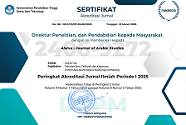Taṭbīq Tarīqat Ḥifẓ al-Naẓam fī Taʿlīm al-Qawāʿid wa-Atharuhū fī Muyūl al-Tullāb wa-Qudratihim ʿalá Fahm al-Qawāʿid al-ʿArabīyah
DOI:
https://doi.org/10.21580/alsina.4.1.12479Keywords:
Naẓam memorization method, qawāʿid learning, stu-dents’ interest, the ability to understand qawāʿidAbstract
The learning method is considered as one of the most important components in the learning process. A teacher should be able to choose and use learning methods that are in accordance with learning objectives and needs of students because it can increase interest and learning outcames. This study aims to determine the effect of applying the nazam memorization method in qawa’id learning on students` interest in learning and the ability to undestand Arabic rules at the Al Hikmah Islamic Boarding School Tasikmalaya. This research is a quantitative reseach with correlational descreptive method. The result showed that the application of the nazam memorization method in qawa’id learning reached an average of 83,16% (very good category), students` interest in learning qawa’id reached an average of 74,8% (good category), the ability to understand the rules of Arabic reached an average of 75,9% (good category), the effect of applying the nazam memorization method in qawa’id learning on students` interest reached 35% meaning that there are other factors of 65% that can affect students` interest in learning, and the effect of applying the nazam memorization method in qawa’id learning on the ability to understand qawa’id reached 36% meaning that there are other factors of 64% that can affect the ability to understand qawa’id.
Downloads
References
Al-ʻImrīṭī, Yaḥyá ibn Mūsá. Al-Durrah al-Bahīyah Naẓm al-Ājurrūmīyah. Edited by Ismāʿīl ibn Ibrāhīm Āl ʿUḍāmī. Giza: Maktabat Awlād al-Shaykh lil-Turāth, 2010.
Al-Ibrāshī, Muḥammad ʻAṭīyah. Al-Tarbīyah al-Islāmīyah wa-Falāsifatuhā. Beirut: Dār al-Fikr, 1969.
Arikunto, Suharsimi. Prosedur Penelitian Suatu Pendekatan Praktik. Jakarta: PT. Rineka Cipta, 2013.
Asy’ari, Hasyim, and Ammar Zainuddin. “Taʿlīm al-Lughah al-ʿArabīyah fī al-Maʿhad al-Salafī wa-al-Maʿhad al-Ḥadīth Namādhijan.” Izdihar : Journal of Arabic Language Teaching, Linguistics, and Literature 1, no. 2 (2018): 167–80. https://doi.org/10.22219/izdihar.v1i2.7298.
Fathudin, Ahmad Ubaedi. Manhaj Taʿlīm al-Lughah al-ʿArabīyah fī al-Maʿāhid al-Salafīyah min Manẓūr Manhaj Taʿlīm al-Lughah al-ʿArabīyah lil-Nāṭiqīn bi-Ghayrihā. Pekalongan: Penerbit NEM, 2018.
Fatlāwī, Suhaylah Muḥsin Kāẓim. Al-Madkhal ilá al-Tadrīs. Amman: Dār al-Shurūq lil-Nashr wa-al-Tawzīʻ, 2003.
Ghofur, M, and Hafidotul Husniah. “Metode Muḥāfaẓah Naẓam Jurūmiyyah untuk Memudahkan Baca Kitab Kuning.” Al-Fusha : Arabic Language Education Journal 4, no. 1 (2022): 10–16. https://doi.org/10.36835/alfusha.v4i1.675.
Goni, Rifanda, Meity Muntuuntu, and Maikel Sanger. “Correlation between Students’ Interest and Their Academic Achievement.” Journal of English Culture, Language, Literature and Education 9, no. 1 (2021): 27–43. https://doi.org/10.53682/eclue.v9i1.1574.
Hanafy, Muh. Sain. “Konsep Belajar Dan Pembelajaran.” Lentera Pendidikan : Jurnal Ilmu Tarbiyah dan Keguruan 17, no. 1 (2014): 66–79. https://doi.org/10.24252/lp.2014v17n1a5.
Hermawan, Acep. Pembelajaran Keterampilan Berbahasa Arab. Bandung: Alfabeta, 2018.
Inayati, Astried Dwi Firliana, and Ali Priyono R. “Pengaruh Metode Pembelajaran Hafalan Kitab Nadham Imrithi terhadap Penguasaan Ilmu Nahwu di MTs Sayyid Abdrurrohman Pagerwojo Perak Jombang.” Journal of Education and Management Studies 2, no. 5 (2019): 49–54. http://ojs.unwaha.ac.id/index.php/joems/article/view/189.
Ingalls, Matthew B. The Anonymity of a Commentator: Zakariyyā Al-Anṣārī and the Rhetoric of Muslim Commentaries from the Later Islamic. Albany: State University of New York Press, 2021.
K, Wowo Sunaryo. Taksonomi Kognitif. Bandung: PT. Remaja Rosdakarya, 2012.
Rusyadi, Muhammad Hilmi Bahar, and Muassomah. “Metode Hafalan dalam Pembelajaran Naḥwu di Madrasah Diniyah Kyai Mojo, Tembelang, Jombang.” Al-Ma‘rifah 17, no. 2 (2020): 119–26. https://doi.org/10.21009/almakrifah.17.02.02.
Slameto. Belajar dan Faktor-faktor yang Mempengaruhinya. Jakarta: Rineka Cipta, 2010.
Sobieroj, Florian. Variance in Arabic Manuscripts: Arabic Didactic Poems from the Eleventh to the Seventeenth Centuries - Analysis of Textual Variance and Its Control in the Manuscripts. Berlin, Boston: De Gruyter, 2016. https://doi.org/doi:10.1515/9783110460582.
Sulthani, Dinil Abrar. “Hubungan Metode Mengajar dengan Minat Belajar di MTs Aisyiyah Ujung Belakang Olo Padang.” POTENSIA: Jurnal Kependidikan Islam 3, no. 2 (December 15, 2017): 163–79. https://doi.org/10.24014/potensia.v3i2.3336.
Ulum, Bahrul. “Metode Menghafal Nadzom Cepat (Studi di Pondok Pesantren Lirboyo, Kediri).” Jurnal Pusaka 11, no. 2 (2021): 13–19. https://doi.org/10.6084/ps.v11i2.646.
Versteegh, Kees. “The Arabic Grammatical Tradition.” Inference: International Review of Science 5, no. 3 (2020). https://doi.org/10.37282/991819.20.40.
Vu, TuongVan, Lucía Magis-Weinberg, Brenda R. J. Jansen, Nienke van Atteveldt, Tieme W. P. Janssen, Nikki C. Lee, Han L. J. van der Maas, Maartje E. J. Raijmakers, Maien S. M. Sachisthal, and Martijn Meeter. “Motivation-Achievement Cycles in Learning: A Literature Review and Research Agenda.” Educational Psychology Review 34, no. 1 (2022): 39–71. https://doi.org/10.1007/s10648-021-09616-7.
Wahyuniarti, Fathimah. Korelasi antara Hafalan Kitab Imriṭi dengan Kemampuan al-Qawāid an-Nahwiyah Santri Kelas Mumtaz Tsani Putri Madrasah Tsanawiyah Salafiyah Pondok Pesantren Al-Tarmasie Pacitan Jawa Timur (Undergraduate Thesis). Yogyakarta: UIN Sunan Kalijaga Yogyakarta, 2016. http://digilib.uin-suka.ac.id/id/eprint/20443/.
Yaqin, Ainul. Metode Hafalan dalam Peningkatan Pemahaman Santri terhadap Kitab Alfiyah Ibn Malik di Pondok Pesantren Riyadlotul ‘Uqul Nampudadi Petahan Kebumen (Master Thesis). Yogyakarta: Universitas Islam Indonesia, 2018. https://dspace.uii.ac.id/handle/123456789/10425.
Downloads
Published
How to Cite
Issue
Section
License
Copyright
The copyright of the received article shall be assigned to the publisher of the journal. The intended copyright includes the right to publish the article in various forms (including reprints). The journal maintains the publishing rights to published articles. Authors are allowed to use their articles for any legal purposes deemed necessary without written permission from the journal, but with an acknowledgment to this journal of initial publication.
Licensing
In order for Alsina: Journal of Arabic Studies to publish and distribute research articles, the editors need publishing rights (transferred from author to publisher). This agreement relates to the transfer/publishing copyright license to Alsina: Journal of Arabic Studies but the authors still have significant rights to use and share their published articles.
Alsina: Journal of Arabic Studies supports the need for writers to share, disseminate and maximize the impact of their research and their rights on any database. As a journal article writer, you have the right to various uses of your articles, including that by the institution or company where you work. Copyright can be used without the need for special permission. Authors who publish articles in the Alsina: Journal of Arabic Studies have broad rights to use their work for teaching and scientific purposes without requesting permission, including:
- Use by the author for lectures, presentations, or conferences, with distribution of copies to participants;
- Distribution to colleagues for research use;
- Use in compilations of the author's subsequent work;
- inclusion in a thesis or dissertation;
- Reuse of sections or excerpts from articles in other works (with full acknowledgment of the final article);
- Preparation of derivative works (other than commercial purposes) (with full acknowledgment of the final article);
- Voluntary posting on open websites operated by authors’ or writers' agencies for scientific purposes
When submitting a manuscript, authors do so on the understanding that if accepted for publication, the copyright for publishing (publishing right) of the article shall be assigned/transferred to Alsina: Journal of Arabic Studies.
Authors whose articles are accepted for publication will receive confirmation via email and sent a Copyright Transfer Agreement.


 Accreditation
Accreditation 
 In Collaboration with
In Collaboration with 

 Visitors
Visitors  Article Template
Article Template





